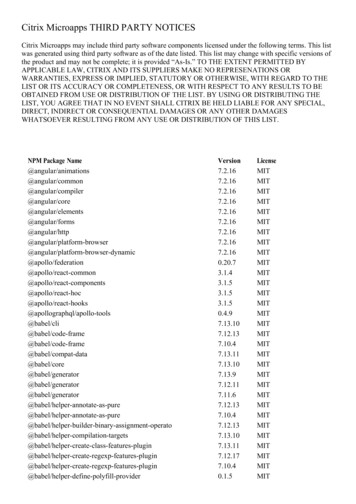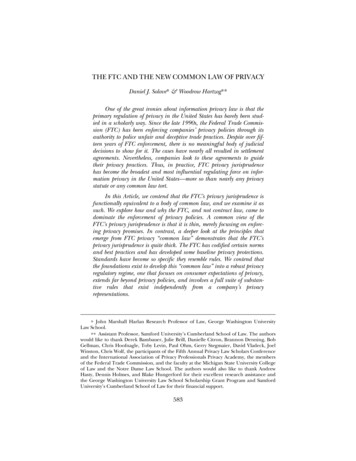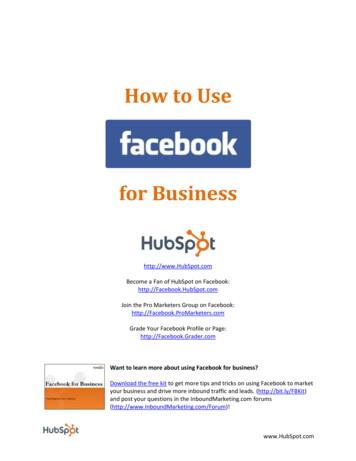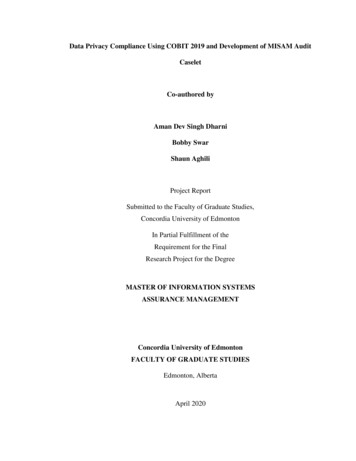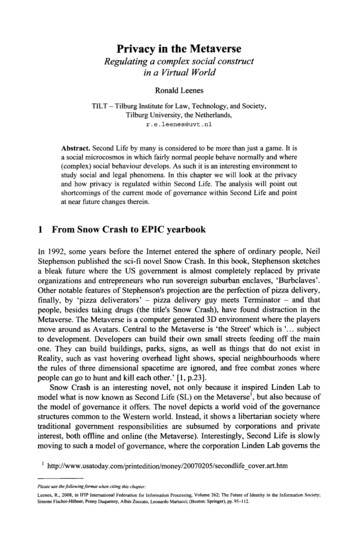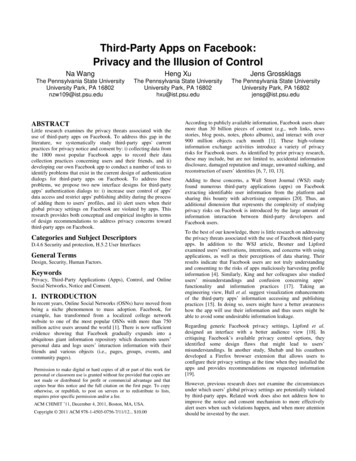
Transcription
Facebook: Threats to PrivacyHarvey Jones, José Hiram SoltrenDecember 14, 2005AbstractEnd-users share a wide variety of information on Facebook, but a discussion of the privacyimplications of doing so has yet to emerge. We examined how Facebook affects privacy, andfound serious flaws in the system. Privacy on Facebook is undermined by three principal factors:users disclose too much, Facebook does not take adequate steps to protect user privacy, andthird parties are actively seeking out end-user information using Facebook. We based our enduser findings on a survey of MIT students and statistical analysis of Facebook data from MIT,Harvard, NYU, and the University of Oklahoma. We analyzed the Facebook system in terms ofFair Information Practices as recommended by the Federal Trade Commission. In light of theinformation available and the system that protects it, we used a threat model to analyze specificprivacy risks. Specifically, university administrators are using Facebook for disciplinary purposes,firms are using it for marketing purposes, and intruders are exploiting security holes. For eachthreat, we analyze the efficacy of the current protection, and where solutions are inadequate,we make recommendations on how to address the issue.1
Contents1 Introduction42 Background52.1Social Networking and Facebook . . . . . . . . . . . . . . . . . . . . . . . . . . . .52.2Information that Facebook stores . . . . . . . . . . . . . . . . . . . . . . . . . . . .53 Previous Work64 Principles and Methods of Research74.1Usage patterns of interest. . . . . . . . . . . . . . . . . . . . . . . . . . . . . . . .74.2User surveys . . . . . . . . . . . . . . . . . . . . . . . . . . . . . . . . . . . . . . .94.3Direct data collection . . . . . . . . . . . . . . . . . . . . . . . . . . . . . . . . . .94.4Obscuring personal data . . . . . . . . . . . . . . . . . . . . . . . . . . . . . . . . .94.5A brief technical description of Facebook from a user perspective . . . . . . . . . . . 104.6Statistical significance . . . . . . . . . . . . . . . . . . . . . . . . . . . . . . . . . . 125 End-Users’ Interaction with Facebook135.1Major trends . . . . . . . . . . . . . . . . . . . . . . . . . . . . . . . . . . . . . . . 135.2Facebook is ubiquitous . . . . . . . . . . . . . . . . . . . . . . . . . . . . . . . . . 145.3Users put time and effort into profiles . . . . . . . . . . . . . . . . . . . . . . . . . 155.4Students join Facebook before arriving on campus . . . . . . . . . . . . . . . . . . . 155.5A substantial proportion of students share identifiable information . . . . . . . . . . 165.6The most active users disclose the most . . . . . . . . . . . . . . . . . . . . . . . . 165.7Undergraduates share the most, and classes keep sharing more . . . . . . . . . . . . 185.8Differences among universities . . . . . . . . . . . . . . . . . . . . . . . . . . . . . 185.9Even more students share commercially valuable information . . . . . . . . . . . . . 205.10 Users are not guarded about who sees their information . . . . . . . . . . . . . . . . 205.11 Users Are Not Fully Informed About Privacy . . . . . . . . . . . . . . . . . . . . . . 205.12 As Facebook Expands, More Risks Are Presented . . . . . . . . . . . . . . . . . . . 215.13 Women self-censor their data . . . . . . . . . . . . . . . . . . . . . . . . . . . . . . 215.14 Men talk less about themselves . . . . . . . . . . . . . . . . . . . . . . . . . . . . . 225.15 General Conclusions . . . . . . . . . . . . . . . . . . . . . . . . . . . . . . . . . . . 226 Facebook and “Fair Information Practices”226.1Overview . . . . . . . . . . . . . . . . . . . . . . . . . . . . . . . . . . . . . . . . . 226.2Notice . . . . . . . . . . . . . . . . . . . . . . . . . . . . . . . . . . . . . . . . . . 226.3Choice . . . . . . . . . . . . . . . . . . . . . . . . . . . . . . . . . . . . . . . . . . 232
6.4Access . . . . . . . . . . . . . . . . . . . . . . . . . . . . . . . . . . . . . . . . . . 246.5Security . . . . . . . . . . . . . . . . . . . . . . . . . . . . . . . . . . . . . . . . . 246.6Redress . . . . . . . . . . . . . . . . . . . . . . . . . . . . . . . . . . . . . . . . . . 257 Threat Model257.1Security Breach . . . . . . . . . . . . . . . . . . . . . . . . . . . . . . . . . . . . . 257.2Commercial Datamining . . . . . . . . . . . . . . . . . . . . . . . . . . . . . . . . . 267.3Database Reverse-Engineering7.4Password Interception . . . . . . . . . . . . . . . . . . . . . . . . . . . . . . . . . . 287.5Incomplete Access Controls . . . . . . . . . . . . . . . . . . . . . . . . . . . . . . . 287.6University Surveillance . . . . . . . . . . . . . . . . . . . . . . . . . . . . . . . . . . 297.7Disclosure to Advertisers . . . . . . . . . . . . . . . . . . . . . . . . . . . . . . . . 327.8Lack of User Control of Information . . . . . . . . . . . . . . . . . . . . . . . . . . 337.9Summary and Conclusion . . . . . . . . . . . . . . . . . . . . . . . . . . . . . . . . 34. . . . . . . . . . . . . . . . . . . . . . . . . . . . . 278 Conclusion348.1Postscript: What the Facebook does right . . . . . . . . . . . . . . . . . . . . . . . 348.2Final Thoughts . . . . . . . . . . . . . . . . . . . . . . . . . . . . . . . . . . . . . 358.3College Newspaper Articles . . . . . . . . . . . . . . . . . . . . . . . . . . . . . . . 379 Acknowledgements9.138Interview subjects . . . . . . . . . . . . . . . . . . . . . . . . . . . . . . . . . . . . 38A Facebook Privacy Policy39B Facebook Terms Of Service41C Facebook “Spider” Code: Acquisition and Processing45C.1 Data Downloading BASH Shell Script . . . . . . . . . . . . . . . . . . . . . . . . . 46C.2 Facebook Profile to Tab Separated Variable Python Script . . . . . . . . . . . . . . 46C.3 Data Analysis Scripts . . . . . . . . . . . . . . . . . . . . . . . . . . . . . . . . . . 48D Supplemental Data56E Selected Survey Comments73E.1 User Feedback . . . . . . . . . . . . . . . . . . . . . . . . . . . . . . . . . . . . . . 73F Paper Survey753
1IntroductionFacebook1 (www.facebook.com) is one of the foremost social networking websites, with over 8million users spanning 2,000 college campuses. [4] With this much detailed information arrangeduniformly and aggregated into one place, there are bound to be risks to privacy. University administrators or police officers may search the site for evidence of students breaking their school’sregulations. Users may submit their data without being aware that it may be shared with advertisers.Third parties may build a database of Facebook data to sell. Intruders may steal passwords, or entiredatabases, from Facebook. We undertook several steps to investigate these privacy risks. Our goalwas to first analyze the extent of disclosure of data, then to analyze the steps that the system tookto protect that data. Finally, we conducted a “threat model” analysis to investigate ways in whichthese factors could produce unwanted disclosure of private data. Our analysis found that Facebookwas firmly entrenched in college students’ lives, but users had not restricted who had access to thisportion of their life. We discovered questionable information practices with Facebook, and foundthat third parties were actively seeking out information.To analyze the extent of user disclosure, we constructed a spider that “crawls” and indexesFacebook, attempting to download every single profile at a given school. Using this tool, weindexed the entire Facebook accessible to a typical user at Massachusetts Institute of Technology(MIT), Harvard, New York University (NYU), and the University of Oklahoma. To supplement thisdata, we surveyed the MIT student body to ascertain the level of use of certain Facebook features.Our study found that upwards of 80% of matriculating freshmen join Facebook before even arrivingfor Orientation, and that these users share significant amounts of personal information. We alsofound that Facebook’s privacy measures are not utilized by the majority of college students. Toanalyze the Facebook system we investigated the facets of the website, and of the terms of useand compared them against the current standards of “Fair Information Practices” as defined bythe Federal Trade Commission, as well as the standards set by competing sites. Although manyFacebook features empower users to control their private information, there are still significantshortcomings. Finally, we took the perspective of a third party acting in a self-interested manner,looking either for financial gain or for assistance in the enforcement of university policy. We surveyednews articles on the consequences of Facebook information disclosure, and interviewed students thatharvested data, as well as students who were punished for disclosing too much. Given the existingthreats to security, we constructed a threat model that attempted to address all possible categoriesof privacy failures. From a systems perspective, there are a number of changes that can be made,both to give the user a reasonable perception of the level of privacy protection available, and toprotect against disclosure to intruders. For each threat, we make recommendations for Facebook, its1“Facebook”, as opposed to “the Facebook”, is how the site’s literature refers to itself. We adopt that terminologythroughout the paper.4
users, and college administrators. These include eliminating the consecutive profile IDs, using SSLfor login, extending “My Privacy” to cover photos, and educating end-users about privacy concerns.22.1BackgroundSocial Networking and FacebookUsers share a variety of information about themselves on their Facebook profiles, including photos,contact information, and tastes in movies and books. They list their “friends”, including friends atother schools. Users can also specify what courses they are taking and join a variety of “groups” ofpeople with similar interests (“Red Sox Nation”, “Northern California”). The site is often used toobtain contact information, to match names to faces, and to browse for entertainment. [4]Facebook was founded in 2004 by Mark Zuckerburg, then a Harvard undergraduate. The siteis unique among social networking sites in that it is focused around universities – “Facebook” isactually a collection of sites, each focused on one of 2,000 individual colleges. Users need an@college.edu email address to sign up for a particular college’s account, and their privileges on thesite are largely limited to browsing the profiles of students of that college.Over the last two years, Facebook has become fixture at campuses nationwide, and Facebookevolved from a hobby to a full-time job for Zuckerburg and his friends. In May 2005, Facebookreceived 13 million dollars in venture funding. Facebook sells targeted advertising to users of itssite, and parters with firms such as Apple and JetBlue to assist in marketing their products to collegestudents. [14]2.2Information that Facebook storesFirst-party informationAll data fields on Facebook may be left blank, aside from name, e-mailaddress, and user status (one of: Alumnus/Alumna, Faculty, Grad Student, Staff, Student, andSummer Student). A minimal Facebook profile will only tell a user’s name, date of joining, school,status, and e-mail address. Any information posted beyond these basic fields is posted by the will ofthe end user. Although the required amount of information for a Facebook account is minimal, thetotal amount of information a user can post is quite large. User-configurable setting on Facebookcan be divided into eight basic categories: profile, friends, photos, groups, events, messages, accountsettings, and privacy settings. For the purposes of this paper, we will investigate profiles, friends,and privacy settings.Profile information is divided into six basic categories: Basic, Contact Info, Personal, Professional, Courses, and Picture. All six of these categories allow a user to post personally identifiableinformation to the service. Users can enter information about their home towns, their currentresidences and other contact information, personal interests, job information, and a descriptive pho5
tograph. We will investigate the amount and kind of information a typical user at a given school isable to see, and look for trends. A major goal of Facebook is to allow users to interact with eachother online. Users define each other as friends through the service, creating a visible connection.My ProfileContains “Account Info”, “Basic Info”, “Contact Info”“Personal Info”, “My Groups”, and a list of friendsThe WallAllows other users to post notes in a space on one’s profileMy PhotosAllows users to upload photographs and label who is in each one.If a friend lists me as being in a photograph, there is a link added frommy profile to that photographMy GroupsUsers can form groups with other like-minded users to showsupport for a cause, use the available message boards, or find peoplewith similar interests.Table 1: Facebook FeaturesThird-party information Two current features of Facebook have to do with third parties associating information with a user’s profile. The “Wall” allows other users a bulletin board of sorts on auser’s profile page. Other users can leave notes, birthday wishes, and personal messages. The “MyPhotos” service allows users to upload, store and view photos. Users can append metadata to thephotographs that allows other users to see who is in the photographs, and where in the photographthey are located. These tags can be cross-linked to user profiles, and searched from a search dialog.The only recourse a user has against an unwelcome Facebook photo posted by someone else, asidefrom asking them to remove it, is to manually remove the metadata tag of their name, individually,from each photograph. Users may disable others’ access to their Wall, but not to the Photos feature.“My Privacy”Facebook’s privacy features give users a good deal of flexibility in who is allowed tosee their information. By default, all other users at a user’s school are allowed to see any informationa user posts to the service. The privacy settings page allows a user to specify who can see them insearches, who can see their profile, who can see their contact info, and which fields other users cansee. In addition, the privacy settings page allows users to block specific people from seeing theirprofile. As per the usage agreement, a user can request Facebook to not share information withthird parties, though the method of specifying this is not located on the privacy settings page.3Previous WorkNo previous academic work specific to Facebook was found on the Lexis databases, Google’s databasefor scholarly papers, the Social Science Research Network, or for “facebook AND journal AND arti6
Visibility to Search?EveryoneRestrictedProfile VisibilityEveryone at schoolFriends of friends at schoolJust friendsContact Info VisibilityEveryone at schoolFriends of friends at schoolJust friendsProfile also shows.My friendsMy last loginMy upcoming eventsMy coursesMy wallGroups that a lot of my friends are inTable 2: “My Privacy” settings (defaults in bold)cle” and numerous other terms in a general web query. Although no journal articles exist, there aremany news articles that have been published about the emergence of Facebook, its incorporationand subsequent venture funding, and recently, the consequences of third parties discovering information that users have made public[14][20][21]. In related fields, the Federal Trade Commissionhas done research into the area of online privacy practices, and has published several reports onthe matter, including the 1998 report to Congress entitled “Privacy Online.” [6] Previous work insocial networking has included a thorough investigation of “Club Nexus”, a site similar to Facebooklocated at Stanford University[1].4Principles and Methods of ResearchIn order to investigate the ways in which Facebook is used, we closely investigated the usage patternsof Facebook. We employ two methods of data collection to learn more about the way users interactwith Facebook. First, we conducted a survey of MIT students on the use of Facebook’s features.Second, we harvested data from the Facebook site directly.4.1Usage patterns of interest.Our main objective in gathering and analyzing Facebook user data was to make statements andgeneralizations regarding the way users use their Facebook accounts. We investigated when userscreate their accounts, and which kinds of users create accounts. Though the friending service is of7
Figure 1: A sample Facebook page. Note the layout, accessible fields, and formation of URL usedto retrieve this page.8
great interest to social network research, for the purposes of our paper, we primarily investigatedthe number of friends users have on the service as an indicator of use, and look for trends.4.2User surveysOur direct user data collection procedure employed both paper surveys and Web based forms to askindividual users questions concerning their Facebook practices.In designing our survey, we aimed for a minimum number of straightforward, multiple choicequestions which would serve to reveal usage patterns, familiarity with various aspects of the service,and opinions on the quality of the service. The questions asked about the subject’s gender, residence,and status, their date of joining Facebook and utilization thereof. It also asked about their knowledgeof Facebook’s Terms of Service, Privacy Policy, and privacy features, as well as their familiarity withFacebook’s practices. We designed the survey such that it would fit on one printed page, andtake approximately three minutes to complete. The complete text of our survey is included as anappendix.In order to diversify the survey results, we gathered data through four routes. We set up a tablein the MIT Student Center, offering students a chocolate-based incentive for completing surveys.We asked classmates in Public Policy, MIT course 17.30J/11.002J, to complete the survey. Viae-mail, we asked the residents of the East Campus, Burton-Conner, Simmons Hall, and RandomHall dormitories to complete the surveys. Finally, we asked all survey takers to notify others of thesurvey.4.3Direct data collectionOur collection of data directly from Facebook served two principles. It served as a proof of concept,to demonstrate that it is possible for an individual to automatically gather large amounts of datafrom Facebook. The collection of data was not entirely trivial, but we were able to produce thescripts necessary to do so within 48 hours. Also, the collection of data from Facebook will provideus with a large, nearly exhaustive and statistically significant data set, from which we can drawvaluable conclusions on usage trends.4.4Obscuring personal dataBefore analyzing data, we aggregated it into a spreadsheet. When we considered sets of more thanone record, we obscured data we deemed to be personally identifiable – Name, Phone Number, AOLScreenname, High School, and Dormitory. These fields were unchanged if left blank by the user,and replaced by “OBSCURED”2 .2Before we developed the software to obscure the data, we did do enough analysis to discover that 48 Facebookusers at the schools we studied have the phone number 867-53099
4.5A brief technical description of Facebook from a user perspectiveFacebook uses server-side Hypertext Preprocesser (PHP) scripts and applications to host and formatthe content available on the service. Content is stored centrally on Facebook servers. Scripts andapplications at Facebook get, process, and filter information on demand, and deliver it to users inreal time, to a Web browser over the Internet. Users begin their Facebook session at the service’stop level site, http://www.facebook.com/.At the main Facebook page, a user can log in to the service, or browse the small amount ofinformation available to the general public. The main page of the service is spartan, and does notprovide any personally identifiable information or technical insight. Facebook does require a schoole-mail address to use their service.To log in to Facebook, users enter their username and password into the appropriate fields onthe page, and click Login. This sends a special URL to the service:http : //www.f acebook.com/login.php?email U SERN AM E@SCHOOL.edu&pass P ASSW ORD(1)Note that this URL contains a user’s login credentials in clear text. This information is vulnerableto detection by a third party. No secure socket layer (SSL) or other encryption is used in logging intot he service.During the login process, the service provides the user’s web browser with some information,which is stored in the form of a cookie. Some of this information, such as the user’s e-mail address,is written to a file so the user does not have to enter his or her e-mail at the next login. Facebook’sservice creates and gives a user a unique checksum at every login, which the browser stores as asession cookie and generally does not write to a file. This checksum varies from login to login, butother parameters do not.Once logged in to the service, a user is free to interact with Facebook. The user may edit theirprofile, look at others’ profiles, add or change their friends lost or personally identifiable information,and explore the service.The majority of features on Facebook are requested via simple, human-readable URLs. Forexample, profile URLs are retrieved by requesting a URL of the form:http : //SCHOOL.f acebook.com/prof ile.php?id U SERID(2)Facebook will read the school and user ID, and give the user either the requested user’s profile page,filtered for privacy by the user’s request before being delivered, or return the user’s home page ifthe profile he requested is blocked or does not exist. The first user at every school is called “TheCreator.” This profile’s USERID is the lowest userid at any given school. The date of its creation isthe date which Facebook was opened to that school. User Ids continue to be assigned sequentiallyfrom the first valid number, created at the time of creation of each new account.10
Facebook’s human-readable URLs and regularly formatted HTML make automated acquisition,parsing, and analysis relatively easy. We discuss how we and others have done this in the nextsection.Each separate school has its own Facebook “server” for its content. Users with a schoole-mail address @SCHOOL.edu will go through http://SCHOOL.facebook.com/.For the mostpart, many of these “servers” redirect to the same machine. For example, harvard.facebook.com,mit.facebook.com, nyu.facebook.com, and ou.facebook.com all redirect to 204.15.20.25. This architecture allows Facebook to easily move different schools to different servers if necessary.By default, a new user’s profile and all information are fully visible to all other users at the sameschool, but not visible to anyone at another school. Many users do not change their default settings,making their information accessible.When a user logs out of Facebook or closes their web browser, the session cookies are lost. Thisgenerally means that once a user exits the service, they must enter at least their password to usethe service again.4.5.1Data acquisitionWe are not the first to download user profiles from Facebook in large numbers. In the past, othershave utilized Facebook’s use of predictable, easy to understand URLs to automatically requestinformation and save user information for further analysis. Our approach used the incrementalprofile identifier to download information in large quantities.The algorithm we used to gather this data is very straightforward:1. Log in to Facebook and save session cookies.2. Load your home page and note the USERID of the page.3. Decrease the USERID until you find the ID of “The Creator,” the first profile at a given school.Save this number as USERID-LOW.4. Increase the USERID until you find the ID of a user who joined recently, i.e. within the pastday. Save this number as USERID-HIGH.5. For every profile from USERID-LOW to USERID-HIGH at a given school SCHOOL: Get theprofile, using URLhttp : //SCHOOL.f acebook.com/prof ile.php?id U SERID(3), and save the profile as a file.To implement our algorithm, we used wget, “the non-interactive network downloader.” Inaddition to implementing the above algorithm, we made wget pretend to be another web browser11
by changing its user agent (to avoid potential suspicion at using wget to log in to Facebook). Wealso had wget randomly insert a delay between requests, to keep load off of Facebook’s servers andmake our requests less difficult to detect. We took advantage of the fact that logins and passwordsare not encrypted, and can be sent as part of the login URL as an email and password pair.The final application we used to download profiles was a short (five line!) BASH shell script,which we include in the appendix.We ran this script four times: once for Harvard, MIT, the University of Oklahoma (OU), andNew York University (NYU).4.6Statistical significanceSurvey data Over the course of the two weeks we ran the survey, 419 MIT students respondedto the questions asked. The users answering our profile questions came from all of campus, withstrong concentrations in dorms where we e-mailed the survey. The respondents were mostly undergraduates (90%). There were 224 female respondents and 195 male respondents. Reflectingan MIT student population of 4,000 undergraduates and 6,000 graduate students, we can find thestatistical significance of our findings using the results of confidence levels and confidence intervalsfrom statistics.The sample size of a survey group is related to the confidence value, the percentage picking achoice, and the confidence interval by the formulaS Z 2 p(1 p)c2(4)Where S is our sample size, Z is a value proportional to the confidence level (1.96 for a 95%confidence interval), p is the percentage picking a choice, expressed as a decimal (with a worst casevalue of 0.5), and c is the confidence interval, expressed as a decimal (i.e. 0.04 0.04). For smallpopulations, we use the correctionS0 S1 S 1P(5)Where S is our original sample size, S 0 is our new sample size, and P is our sample population. [17]Our survey results are good enough to make coarse extrapolations to the MIT community ingeneral. At a confidence level of 95%, and a sample size of 419 applying to an MIT student population of 10,000 total undergraduates and graduate students, and a worst case answer uncertainty of50%, we find our confidence interval to be 4.68%. In other words, we can be 95% certain that oursurvey responses fall within 4.68% of the true values. At a confidence level of 99%, our uncertaintyincreases to 6.17%.Collected Facebook data In general, we were able to collect large numbers of user profilesfrom Facebook using our information collection system. We exhaustively downloaded every profile12
available at our four subject schools, so there is no sampling uncertainty, as long as we limit ourconclusions to generalizations about the population of students with accessible Facebook profiles.We will attempt to statistically correlate certain variables to prove hypotheses, and at other pointswe will show raw data when we want to indicate a trend. The following table summarizes our successin downloading information.Success Rates In Downloading ProfilesSchoolNumber ProfilesNumber 1770466.16%Oklahoma 1172.28%Aggregate StatisticsWe established a ”disclosure score” to quantitatively rank the amount ofPII disclosed by different colleges, classes, and genders. The overall score is the sum of the percentage disclosure of (Gender, Major, Dorm, High School, AIM Screenname, Mobile Phone, Interests,Clubs, Music, Movies, and Books). From there, we created two sub-scores, one to reflect contactinformation that could conceivably be used to contact or locate users (Dorm, AIM Screenname, Mobile Phone, and Clubs/Jobs), as well as a sub-score reflecting disclosure of user interests (Interests,Clubs/Jobs, Music, Movies, and Books).55.1End-Users’ Interaction with FacebookMajor trendsAfter processing the results of our user survey and downloaded Facebook profiles, we found somegeneral trends in Facebook usage. Facebook is ubiquitous at the schools where it has been established. Users put real time and effort into their profiles. Students tend to join as soon as possible,often before arriving on campus. Users share lots of information but do not guard it. Users giveimperfect explicit consent to the distribution and sharing of their information. Privacy concernsdiffer across genders.In the following pages, we analyze the collected data along numerous lines, and statisticallyjustify our findings. Our full numerical findings are included in the appendix.13
Figure 2: Number of Profiles identifying as a class divided by students in that class5.2Facebook is ubiquitousPossession of a Facebook accountSurvey results indicated that large majority of MIT studentshave Facebook profiles. Of 413 respondents, 374 (91%) claimed to have Facebook accounts, whileonly 39 (9%) did not. Indexing the Facebook seemed to indicate a similar result; the vast majorityof undergraduates have Facebook accounts. Although fake accounts could bloat the number ofaccounts, the fact that the Facebook user base is quite similar to the MIT undergraduate populationpoint to the fact that a large percentage of Facebook users are genuine. There are 948, 1016, and 921accounts that provide the class years of 2007, 2008, and 2009, respectively, compared to a class sizeof roughly 1,000. As shown below, the majority of Facebook accounts are updated at least monthly,which fits the profile of large numbers of users updating information about themselves. Aside fromher romantic attachments perhaps, a Paris Hilton account 3 would not need to be constantly updated.At NYU, where potential pranksters are limite
threats to security, we constructed a threat model that attempted to address all possible categories of privacy failures. From a systems perspective, there are a number of changes that can be made, both to give the user a reasonable perception of the level of privacy protection available, and to protect against disclosure to intruders.
